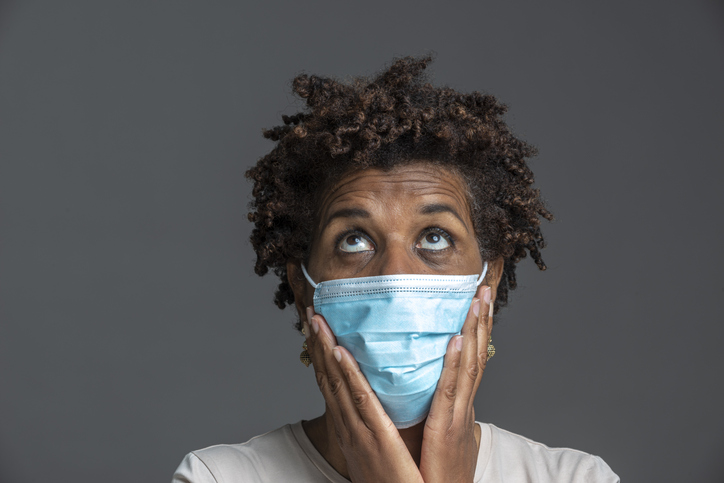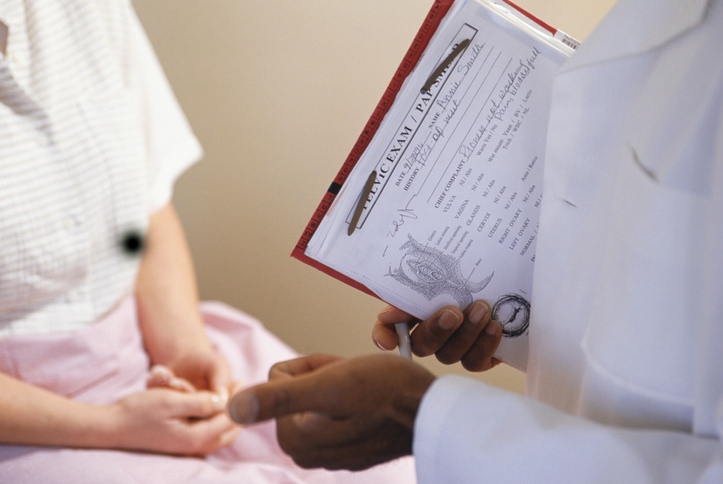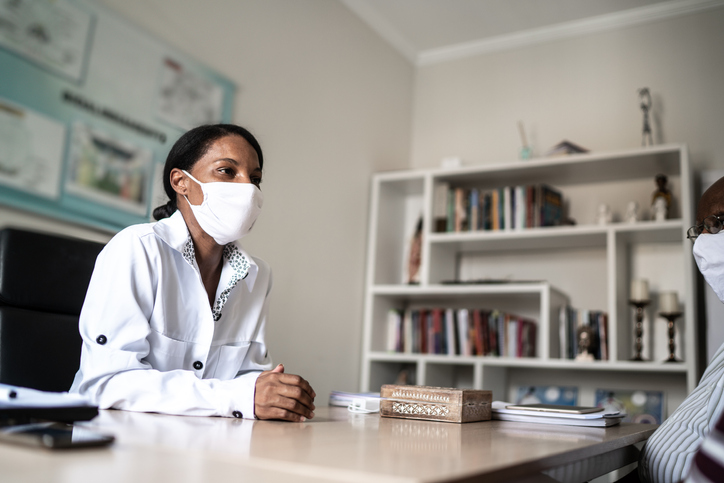So You Got An Abnormal Pap. Now What?
Share the post
Share this link via
Or copy link

Source: Peter Dazeley / Getty
“It’s just routine,” “It’s standard procedure,” “It’s just in case,” “It’s only a precaution.” These are the things we say to ourselves when going in for our regular pap smears – or regular medical exams of any kind. Most patients enter a doctor’s office for a routine exam expecting to leave with nothing more than brownie points for showing up, doing their due diligence, and being perfectly healthy. Statistics say it’s very unlikely the doctor will find anything, right? But, unlikely is not the same as impossible. Whatever the figures are – 90 percent are fine, or 98 percent are fine – somebody makes up that ten percent, or two percent. And it really sucks when it’s you.
Our first inclination is usually to dive into the unpredictable world wide web for answers, but it’s far better to consult a certified expert when there’s an abnormality. We spoke with Dr. Lorie Johnson, a Board-certified Ob/Gyn and the owner of Just For You Women’s Healthcare, a private practice in Atlanta, Georgia.

Source: NA / na
What are the causes of abnormal paps?
“One of the main causes of an abnormal pap is HPV, which is an STD, and is probably the most common STD that we see nowadays,” says Johnson. “It’s spread virally, and its symptoms are very insidious. Many people don’t have any symptoms at all so it gets spread very easily. Other causes can be inflammation, or anything going on in your own body like an infection, or an autoimmune condition.”
Love MadameNoire? Get more! Join the MadameNoire Newsletter
We care about your data. See our privacy policy.
Dr. Johnson adds that sometimes an abnormal pap can occur simply because the pap was performed too close to your period, so some additional cells pop up.

Source: sturti / Getty
How concerned should you be?
“Your pap smear was abnormal” is a rather vague diagnosis, Dr. Johnson explains. “There are five different designations for abnormal. You have everything from normal all the way to cancer and five different subcategories in between. The closer you are on the cancer diagnosis end, the more worried you should be. If it’s just abnormal, you shouldn’t be too worried.”

Source: momcilog / Getty
A look at the different strains
“There are 40 or so different subtypes of HPV. Twelve are considered high-risk HPV. They are more highly associated with cervical cancers,” says Dr. Johnson. “Some of the main ones we see are strains 16 and 18. Having high-risk HPV does not mean you’re going to get cancer. It just means that a lot of people who have had cervical cancer, had those two subtypes. Some of the other subtypes might cause genital warts but are not highly associated with cancer.”

Source: pidjoe / Getty
What if you get the vaccine and still get HPV
The Gardasil vaccine guards against four of the high-risk strains of HPV: 6, 11, 16, and 18. But, it’s important to note that Gardasil was the original HPV vaccine. Now Gardasil 9, which came out in 2017, is the newest form and offers greater protection against even more strains of HPV.
“There are 12 high-risk strains, so you can get HPV of a different subtype that’s also high risk that Gardasil didn’t protect you from,” says Dr. Johnson.

Source: Keith Brofsky / Getty
What if you’ve had an irregular pap before?
I had an abnormal pap smear about a decade ago. Then all my paps were normal since then, and I had one partner the entire time. So I wondered: is it possible that the HPV strain I had a decade ago (which was not a high-risk strain) mutated into this new strain? Dr. Johnson assured me that the strains cannot mutate. So that just means that, somewhere along the line, I picked up this other, riskier strain. But when?

Source: SDI Productions / Getty
HPV can be asymptomatic for years
The fact that I’ve had just one partner since my irregular pap smear 10 years ago is irrelevant, says Dr. Johnson. “HPV can be in your system for up to 10 years before it shows symptoms. Because HPV is a virus, it tends to present itself when the body is down for other reasons. It’s an opportunist. So if you have stress going on, or were sick for another reason, the virus may present itself in that space.”

Source: SDI Productions / Getty
Just how long could you have had it?
For many women, when you get that diagnosis of HPV, you start to do the math. Who have you been with? When? How long have your pap smears been normal? If it doesn’t add up, know that Dr. Johnson informed me, “We weren’t always looking for HPV. So people can say ‘I’ve never had it before,’ but we weren’t always actively testing every woman for it like we are now.” In other words, you may have had it and just not known.

Source: PeopleImages / Getty
What about your partner?
One immediate concern when you get diagnosed with an STD is, of course, “What about my partner?” There is no testing for HPV in men. But, Dr. Johnson states, if men do have it, “They can get genital warts on their penis, or in the pelvic area.” Unfortunately, she says these often get overlooked. “Unless they’re large warts, sometimes they go unnoticed because they’re flesh-colored and don’t really hurt. They can be mistaken for skin tags.”

Source: hobo_018 / Getty
Can it cause cancer in men?
The big concern when we talk about HPV and cancer is cervical cancer. Men don’t have a cervix so, we asked Dr. Johnson, are there any cancers they should look out for if they suspect they have HPV?
“There is risk for penile cancer. In same-sex relationships, there’s a higher risk of rectal cancer and testicular cancer.” Having HPV increases a man’s odds of developing one of these cancers by 20 percent across the board. She adds that HPV is also a major cause of Oropharyngeal cancer (mouth and throat).

Source: FG Trade / Getty
How fast does HPV progress?
If you test positive for high-risk HPV and have abnormal cells, you probably want to know how fast that can turn into something else, if left unchecked. “That’s the tricky part,” says Dr. Johnson. “It may never progress to something else. It may remain at that level. It’s hard to say…if you get the mildest form…the ascus form…the odds of it progressing are unlikely. But if you have a high-grade or low-grade lesion, there is a higher chance of it progressing to cancer.”

Source: LifestyleVisuals / Getty
How often should you get paps now?
“If you have an HPV diagnosis, just do your annual pap smear,” advises Dr. Johnson. Though she admits, not all doctors see eye to eye on this. “It’s controversial. Some say you can just do it annually until a certain amount of paps are normal.” But she thinks anyone who has ever tested positive for high-risk HPV should go in annually for pap smears. “Once the presence is there, it can progress if not checked. A lot of my colleagues have a patient who skipped a year or two of pap smears, and came back with something serious.”

Source: RgStudio / Getty
A pap smear versus a colposcopy
If you test positive for high-risk HPV and your pap smear shows abnormal cells, the next thing your doctor will recommend is a colposcopy. “A Pap smear is like a screening. We’re just brushing over the surface of the cervix, getting a random sampling of cells. A colposcopy looks through a microscope that enlarges it, and picks out specific areas of abnormality. The doctor may see an area they want to biopsy. If that tissue is of a higher grade of abnormality than what was found on the pap, the doctor may recommend further treatment.”

Source: momcilog / Getty
What is the further treatment?
If the doctor deems it necessary, she will either recommend LEEP (loop electrosurgical excision procedure) or Cryotherapy. With LEEP, problematic cells are surgically removed. In Cryotherapy, they are frozen off. Which one will your doctor recommend, if necessary? “That depends on the doctor and what the patient wants,” says Dr. Johnson. But she says that she prefers LEEPs because that tissue that’s collected will go to a pathologist and they can tell her if she got all the abnormal cells. “With Cryotherapy, you’re not sure if you penetrated deep enough to get all the abnormal cells.”

Source: Viktorcvetkovic / Getty
What is the success rate of treatment?
“A lot of it depends on the patient, and the strain of HPV, and the patient’s lifestyle. For instance, smokers will have a lot of issues with recurrence. But some have a LEEP and never have a problem again.” Dr. Johnson added that some habits and conditions make it more likely for HPV to present symptoms in the first place, progress, and come back. Those include smoking, uncontrolled diabetes, immunosuppressant medications, and steroids.

Source: FG Trade / Getty
An important message from Dr. Johnson
“In general, women have to be the advocates for their own health and not forget about their own health. We spend so much time thinking about others and worrying about our husbands and kids that we put ourselves on the back burner and that’s when we’re not taking care of ourselves.”
-

Style, Swagger, And Star Power: Rihanna, Ciara, Olandria, Angel Reese And More Shine At The 2025 CFDA Fashion Awards
-

From Slammer To Glamour: Watch 'Real Housewives Of Potomac' Star Karen Huger Freed Early From Jail In Full Makeup Beat
-

How Fit Women Eat In Group Settings
-

Mompreneurs: iOne SVP Allison McGevna Talks Breaking Revenue Records And Scheduling Time For Creativity



